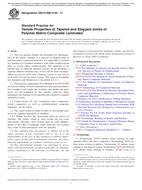1.1 This test method describes a steady state technique for the determination of the thermal conductivity, [lambda], of homogeneous-opaque solids (see Notes 1 and 2). This test method is for materials with effective conductivities in the approximate range 0.2 ∧ [lambda] ∧ 200 W/ [dot]K over the approximate temperature range between 90 and 1300 K. It can be used outside these ranges with decreased accuracy.
Note 1-For purposes of this technique, a system is homogeneous if the apparent thermal conductivity of the specimen, [lambda] , does not vary with changes of thickness or cross-sectional area by more than +5%. For composites or heterogeneous systems consisting of slabs or plates bonded together, the specimen should be more than 20 units wide and 20 units thick, respectively, where a unit is the thickness of the thickest slab or plate, so that diameter or length changes of one-half unit will affect the apparent [lambda] by less than +5%. For systems that are non-opaque or partially transparent in the infrared, the combined error due to inhomogeneity and photon transmission should be less than +5%. Measurements on highly transparent solids must be accompanied with infrared absorption coefficient information or the results must be reported as apparent [lambda] . Note 2-This test method may also be used to evaluate the thermal conductance/resistance of materials in contact.
1.2 This standard does not purport to address all of the safety concerns associated with its use. It is the responsibility of the user of this standard to establish appropriate safety and health practices and determine the applicability of regulatory limitations prior to use.
Product Details
- Published:
- 03/10/1999
- Number of Pages:
- 8
- File Size:
- 1 file , 160 KB


